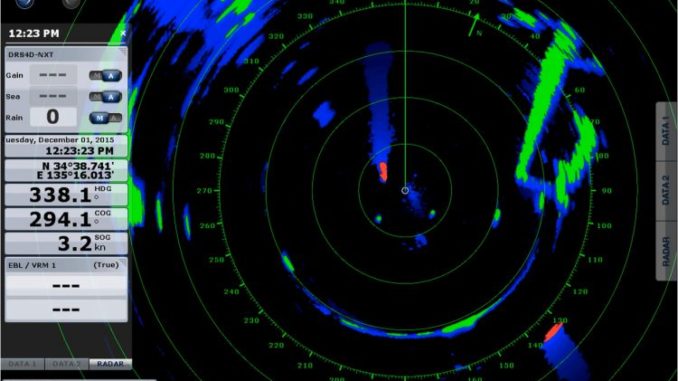
Solid state and state of the art
Ask three fishermen what they like most about their radar units and you might well get three different answers.
The most-experienced user might tell you it ties with sonar as his most valuable fishing tool.
When the big fish he’s after attacks a baitfish school, at least some of the fleeing forage head for the surface and jump out of the water to escape. The big ones are right behind them and the slashing, splashing melee produces enough white water to be seen by sharp-eyed gulls a mile away.
The gulls know more about this process than we do, and when they are not competing with the game fish for their prey they are keeping an eye out for just that opportunity.
Most experienced radar users who are confident that their units can detect and display birds are also well practiced in setting them up to do so. This usually calls for cranking the gain to maximum or at least high enough to show interference on the screen, and then picking the stronger bird targets out of the clutter.
This is much easier to do using color displays that show different target strengths in different colors. You might see all the clutter in green, for instance, and the stronger bird returns in red and yellow — an easily seen contrast.
These users know to leave their rain and sea clutter filters off or set very low because they can make the birds look like dense, continuing patches of noise and hide them.
Setting the radar up to show target trails can also help; if the birds are moving at a steady speed, they are probably cruising and looking for the same thing you are, but if they are concentrated in one stationary spot (i.e., not leaving a trail) then the party has probably already started and you’re late.
The second radar user might say he likes his unit’s ability to confirm his position relative to the world around him.
GPS mapping and charting is very good at showing your position in relation to land masses, bridges, buoys and other permanent landmarks, but radar absolutely confirms it.
Radar also shows and tracks uncharted movable objects like other boats, ships and barges. And radar can show these things on a separate radar-only screen, as an overlay on your GPS chart view or both.
This ability extends right down to threading a safe path between buoys and finding a harbor mouth in darkness or fog.
This brings us to what your third user might like best: extra safety in the form of a constant, dynamic ability to avoid collisions.
A guard alarm can be set to warn when objects enter a set, 360-degree perimeter around your boat. It looks ahead for dangers you are approaching and for others coming toward you from either side or behind.
Radar can see moving targets around you, mark them and show their direction of travel to help you avoid them.
Furuno’s new DRS4D-NXT radar ticks all these boxes and then some.
Starting with our third user’s example, the NXT unit uses Doppler technology and screen color to let you see at a glance which targets are a collision risk and which are not.
When its Target Analyzer feature is engaged, all targets that are getting closer to your boat at a speed of 3 knots or higher are shown in red, while everything else is displayed in green.
Closing objects could be stationary objects in your path, other boats headed toward you or boats you are overtaking at a rate faster than 3 knots.
There is no need to monitor the track and direction of each target separately and then determine whether or not they present a collision hazard. It couldn’t be simpler: Green means safe and red means potential danger.
A Fast Target Tracking feature lets you display and track up to a hundred targets simultaneously, and seconds after you select one it displays the target’s vector (direction of travel) and speed and continues to track them all with every antenna sweep.
If the target is moving toward your boat, it also sounds an alarm.
Target trails and Furuno’s True Trail feature show a trail behind each moving target that lets you see its direction of travel independent of your own boat’s movement.
The second user we talked about was concerned with radar as a navigational tool. He is going to like the new RezBoost feature Furuno borrowed from its sonar technology and adapted to this new NXT radar unit.
The unit uses a 24-inch radome scanner, and they are not known for delivering extraordinarily narrow beam resolution. This unit’s standard resolution delivers a natural horizontal beam width of 3.9 degrees, but with RezBoost beam sharpening set at maximum, Furuno says this little radome projects the sharpness equivalent of a 2-degree beam from a larger open-array antenna.
This means more target detail and less clutter.
The NXT’s solid-state, pulse-compression Doppler radar requires no warm-up time, has 25 Watts of output power and offers range scales from 0.0624 to 36 nautical miles.
Working our way back to that first advanced radar user, Furuno included a new Bird Mode in the NXT that does most of the work. Just turn the feature on, and the unit automatically adjusts gain and sea settings for the proper echo enhancement to help locate birds.
Furuno recently won the National Marine Electronics Association’s Best Radar Award for the 40th year in a row, which might explain the extra attention the company’s new radar advancements get.
This new unit’s “NXT” designation stands for “next generation,” and it appears to take a healthy swing at providing open-array performance in a radome scanner compact enough for smaller, easily trailerable boats.
The unit is designed to be networked with Furuno’s NavNet TZtouch and TZtouch2 system multi-function displays, and it is priced at $2,600.
Visit www.furunousa.com for more information.




